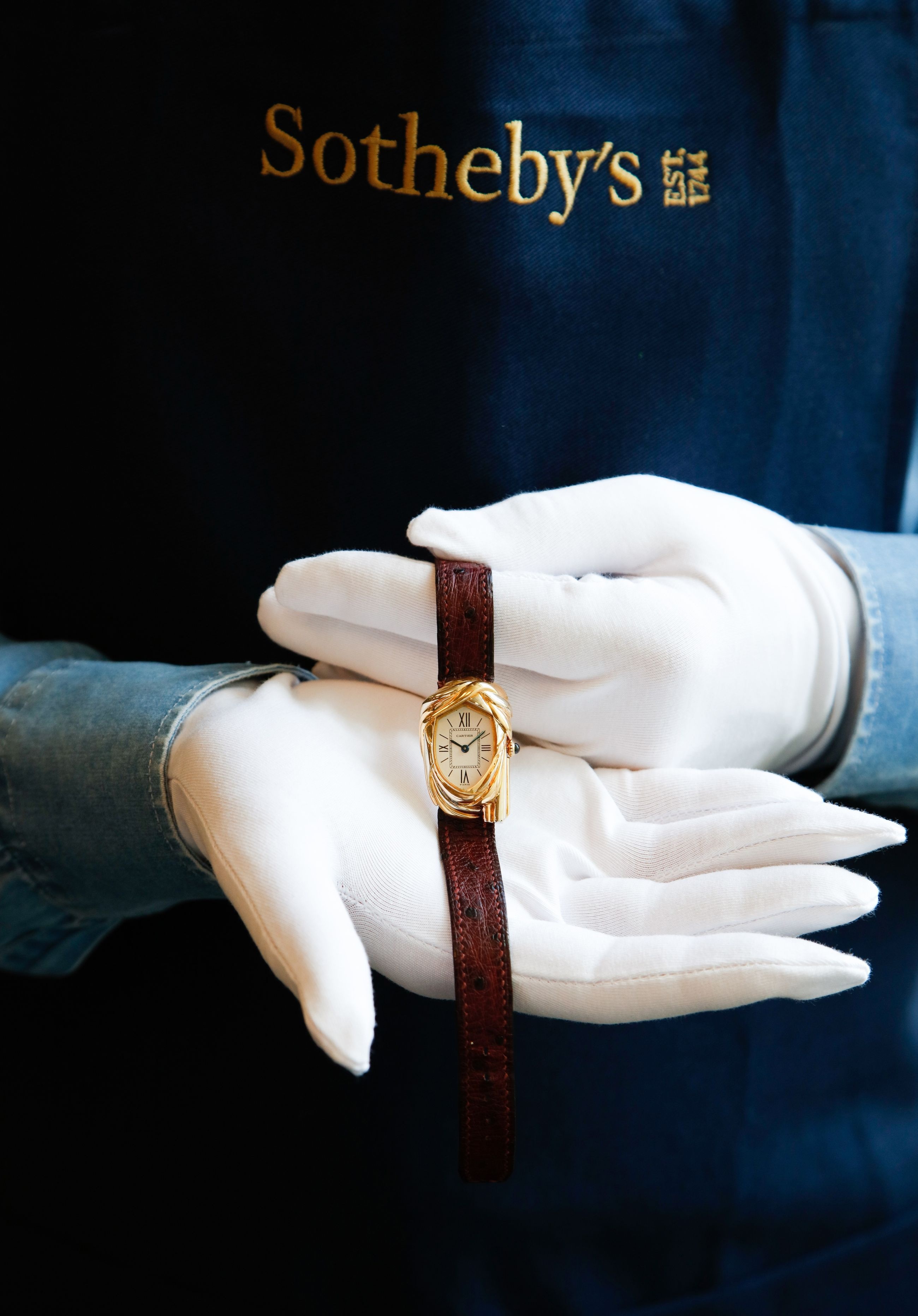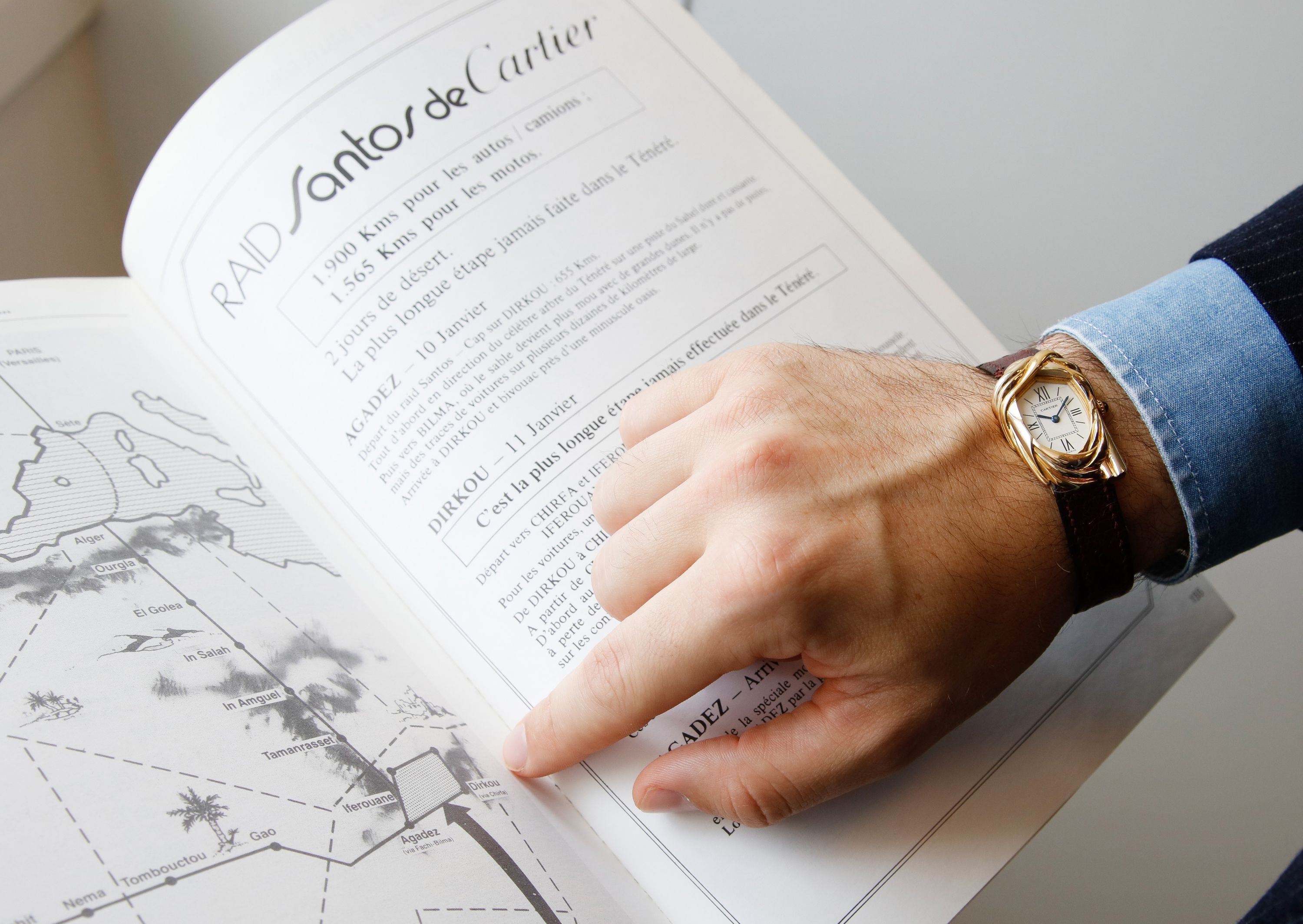The Mythical Cartier "Cheich" Watch at Sotheby's Paris in September
A watch with a history steeped in triumph and tragedy awarded to legendary racer Gaston Rahier at the 1985 Dakar Rally for winning the Cartier Challenge, the world’s most demanding race Is to be offered for the first time at Sotheby’s Paris in September. Estimated at €200,000-€400,000.
“There are so many reasons why the Cartier Cheich watch is extraordinary, it is hard to just pick one. As a true horological masterpiece, and for its association with the triumph and tragedy of the legendary Cartier Challenge, it has achieved near mythical status and the market has been longingly waiting for its first appearance at auction. Nothing quite like it would ever be made again, and its reemergence now from the family of the great champion to whom it was awarded, like a holy grail, is any serious watch collector’s dream. 40 years after it was conceived, I am amazed at how audacious the watch’s design still looks today as Cartier sought to radically reinvent what they were the very first to create: a pilot wristwatch. There is no doubt that this Cheich watch, the only one awarded and the only one to come from private hands, is one of the most important Cartier wristwatches ever made.” Benoît Colson, International Watch Specialist, Sotheby’s
Monaco, Tuesday 12 July – Today, Sotheby’s has unveiled one of the world’s great watch unicorns – The 1983 Cartier Cheich watch. This unique model was born from the legendary collaboration between Cartier and one of the world’s most famous transnational races, The Paris-Dakar (now mostly known as The Dakar Rally), and the two men behind those brands – Alain Dominique Perrin, Cartier’s then President, and Thierry Sabine, the founder of the race and racing driver himself. The watch, which boasts truly extraordinary history and provenance, is estimated at €200,000 to €400,000, and will be auctioned at Sotheby’s Paris this September during its Luxury Edit sale series.
The Cartier Cheich watch is currently on view at Sotheby’s Monaco gallery until Sunday 17th July, as part of a multi-category exhibition featuring fine jewellery, pieces from Sotheby’s Diamonds, handbags, and important artworks by Claude and François-Xavier Lalanne. The watch, which is in pristine condition, will be exhibited again in Paris before its auction on 30th September. Not seen in public in almost 40 years the watch will be offered by the family of its original owner, the much-lauded Belgium-born Gaston Rahier (1947 Chaineux, Belgium – 2005 Creil, France), considered to be one of the greatest ever mechanical sports champions.
Historical Context
In 1983, on the occasion of the 5th anniversary of the Paris-Dakar – a 10,000-kilometer, unforgiving and perilous rally across France and the splendor of the African desert, open to any suitable motorized land vehicles – Alain Dominique Perrin and Thierry Sabine, created the Cartier Challenge whose winner would be awarded a bespoke Cartier Cheich watch. To qualify as worthy winner, the contender needed to win the race twice, in the same motoring category (bike, car, or truck) in two consecutive years – a feat so extraordinary that it was deemed to be nigh on impossible and, de facto, became the world’s ultimate racing challenge. Gaston Rahier won the challenge in 1984 and in 1985, making him the first and only winner of the Cartier Challenge, becoming the sole recipient of the Cartier Cheich watch as the winning trophy celebrating his staggering achievement.
The Cartier Cheich, designed to reflect the spirit of the Paris-Dakar, by Jacques Diltoer, the then Creative Director of Cartier and Perrin, was inspired by the rally’s logo featuring the silhouetted face of a Tuareg wearing a ‘cheich’ (or in French ‘chèche’), a traditional piece of cloth worn around the head as a protection against the sun. Only fourmodels were ever created: the original two Cartier Cheich watches designed in 1983, one for a man (that was awarded to Gaston Rahier) and another for a potential female winner. A third was created in 1985 for another possible future champion. A fourth piece was offered to Thierry Sabine by Alain-Dominique Perrin. It is thought that this watch may have been given, eventually, to Hubert Auriol, a famous French motorbike race driver, but it is now considered lost.
However, 1986 was to mark both the end of the Cartier Challenge, and the end of the production of the Chartier Cheich. Towards the end of the 1986 Paris-Dakar Rally, Thierry Sabine was victim of a helicopter crash in Mali caused by a sandstorm. The crash killed not only Sabine, but another four people – including one of France’s most beloved singers, Daniel Balavoine, who was then at the zenith of his fame. Although the rally ran its course that year, no one won the Cartier challenge which was cancelled shortly afterwards, after running for only four years. Today, the other two Cartier Cheich watches remain in Cartier’s collection.
Although all three share similarities in the overall aesthetic, each feature unique design details: the sole ladies watch is smaller in size and diamond set, whilst the dial of the third watch, created after Gaston Rahier’s historic win, incorporates elongated Roman and baton indexes and no rail track. While the Cheich is one of the most important and mythical wristwatches ever made by Cartier, the ‘Rahier’ – the only one given to a winner of the Cartier Challenge - is the only example that will ever be on the market.
The Cartier Cheich – A Design Masterpiece
Never before had a watch adopted such a radical yet elegant shape. With the Cheich model, Cartier created an extremely audacious design that has never been replicated in the same way since. While the size of the timepiece can today be considered classic, its aura and charisma are simply staggering.
In Detail: The Cartier Cheich
The watch comes in its original box: a bespoke presentation case in legendary Cartier red with gold detailing. Its shape is very different to any other with its curved triangular shape, reminiscent of the dunes of the desert. Inside, the lid is marked “Trophée Paris Alger Dakar” under the Cartier signature.
Paris Dakar – The race and its origins
Created by the motorcycle racer Thierry Sabine, the first edition of the Paris Dakar took place in December 1978. The idea of this rally arose during the Abidjan-Nice rally when Sabine got lost in the Libyan desert. He felt in love with the breathtaking landscapes and wanted to reveal the magic of this place to other motorsport enthusiasts.
The Paris-Dakar was open to everyone, amateurs or professionals, and was the most demanding race ever created, starting in Paris, ending 10,000 kilometers later, in Dakar, Senegal.
Since its inception, the race has proven to be human and sportive challenge like no other for all the participants. Historically, only a minority of participants manage to finish the race due to technical issues, accidents, getting lost in the inhospitable environment, reaching physical and mental limits and occasionally fatalities. The twenty-day rally is infamous for meeting competitors with unpredictable and extreme weather conditions, with 35° during the day and 0° overnight, making every day a 24-hour struggle with only precarious camping to rest at night. The competition was opened to cars and trucks, but the motorcycle riders have always been considered the true heroes of the event.
The rally captured the public’s imagination and was an instant national and international hit, with extensive media coverage supporting the huge popular interest. Even the start of the challenge in 1978 was broadcast live on TV. Televisual audiences were fascinated by the human, technical and geographic dimensions of the competition but also by the many celebrities taking part in the race year after year. There was a fascination with how professionals, amateurs, unknown participants and famous faces were made all equal by the nerve-shredding and physically taxing rally. Beyond the competitive aspect of the rally, participants famously helped each other through the upheavals of the race, they shared an explorer’s spirit and a deep respect to the territories they crossed. For its founder Thierry Sabine, the heart and soul of the Paris-Dakar combined adventure, camaraderie, pushing oneself and the mechanics to their limits in some of the most beautiful landscapes of this planet.
Gaston Rahier (1947 Chaineux, Belgium – 2005 Creil, France)
Gaston Rahier was born in 1947 in Chaineux, Belgium and is considered one of the greatest champions in mechanical sports in history. Indeed, the “little man with the giant reputation” – a nickname he gained due to his short 1m57cm stature, won many of the most important international racing competitions several times.
He started his career in motocross and won the Junior Belgian Championship at the age of 16 and a few years later, in 1967, he won his first Belgian Championship. He was World Champion three times in a row, from 1975 to 1977 with Suzuki and then went on to ride on Yamaha and Gilera with whom he won many other international competitions.
In 1982, he had a terrible accident during a race and nearly severed his hand, leaving his doctors to predict the end of his career. Nevertheless, thanks to his immense determination, he started rally competitions again the following year. Indeed, in 1983, he participated in the Paris Dakar for the first time, riding a BMW R80DS with Hubert Auriol in his team. Unfortunately, he had to abandon the rally after a fall but he came back the year after that and won the competition before winning again the next edition in 1985. Gaston Rahier was the first non-French person to win the Paris Dakar and the only one to win the Cartier Challenge. He was elected Sportman of the year in Belgium and continued competing until 2000, winning over 1,000 races in his career.
He also lived his passion by training and coaching young moto pilots as well as by creating new rallies. As a complete athlete, he was also an excellent car driver – he participated in the legendary Le Mans, was a talented plane pilot as well as a very good tennis player and skier.
Gaston Rahier passed away in 2005, at the age of 58, after fighting cancer.


















Comments
Leave a comment